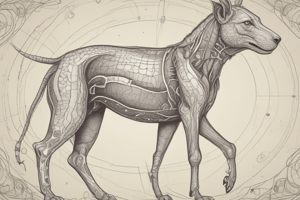Podcast
Questions and Answers
What is the primary focus of veterinary physiology?
What is the primary focus of veterinary physiology?
- Understanding functions and mechanisms in animal bodies (correct)
- Examining agricultural practices
- Studying human anatomy
- Researching microbial life in veterinary settings
Which type of muscle tissue is responsible for involuntary movements and is found in organs?
Which type of muscle tissue is responsible for involuntary movements and is found in organs?
- Skeletal muscle
- Smooth muscle (correct)
- Cardiac muscle
- Striated muscle
What does the term homeostasis refer to in veterinary physiology?
What does the term homeostasis refer to in veterinary physiology?
- The regulation of body temperature only
- The development of new species over time
- The ability to maintain stable internal conditions (correct)
- The process of muscle repair after injury
In the nervous system, what are the two main divisions?
In the nervous system, what are the two main divisions?
What is a key function of the renal system in veterinary physiology?
What is a key function of the renal system in veterinary physiology?
Which process is primarily responsible for gas exchange in the respiratory system?
Which process is primarily responsible for gas exchange in the respiratory system?
The endocrine system is primarily involved in what type of regulation?
The endocrine system is primarily involved in what type of regulation?
How does comparative physiology contribute to veterinary medicine?
How does comparative physiology contribute to veterinary medicine?
Flashcards are hidden until you start studying
Study Notes
Overview of Veterinary Physiology
- Study of the functions and mechanisms in animal bodies.
- Focuses on various species including domesticated animals and wildlife.
Key Concepts
-
Homeostasis
- Maintenance of stable internal conditions despite external changes.
- Involves feedback mechanisms (positive and negative).
-
Cell Physiology
- Understanding cellular structures (e.g., membrane, cytoplasm, organelles).
- Processes such as metabolism, cell signaling, and division.
-
Muscle Physiology
- Types of muscle tissue: skeletal, cardiac, and smooth.
- Mechanisms of contraction (sliding filament theory).
-
Nervous System Physiology
- Structure and function of the central (CNS) and peripheral nervous systems (PNS).
- Neurotransmission mechanisms and reflex arcs.
-
Circulatory System
- Heart structure and function.
- Blood flow dynamics, gas exchange, and blood pressure regulation.
-
Respiratory Physiology
- Breathing mechanics (inhalation and exhalation).
- Gas exchange in lungs and tissues.
-
Digestive Physiology
- Anatomy of the digestive tract.
- Processes of digestion, absorption, and metabolism of nutrients.
-
Endocrine System
- Hormonal regulation and signaling pathways.
- Major glands (pituitary, thyroid, adrenal) and their functions.
-
Renal Physiology
- Kidney structure and function.
- Filtration, reabsorption, secretion, and excretion processes.
-
Reproductive Physiology
- Male and female reproductive systems.
- Hormonal cycles, gametogenesis, and gestation.
Practical Applications
- Diagnosis and treatment of disease.
- Understanding physiological changes in response to stress, disease, and environment.
- Development of veterinary medicines and surgical techniques.
Comparative Physiology
- Study of physiological differences and similarities across species.
- Important for species-specific treatments and care.
Importance in Veterinary Medicine
- Essential for effective diagnosis and treatment.
- Aids in understanding animal behavior and physiology-related disorders.
Overview of Veterinary Physiology
- Examines functions and mechanisms within the bodies of various animal species, including domesticated animals and wildlife.
Key Concepts
-
Homeostasis
- Ensures stable internal conditions despite external environmental changes.
- Utilizes feedback mechanisms, which can be positive or negative, for regulation.
-
Cell Physiology
- Focuses on cellular components such as membranes, cytoplasm, and organelles.
- Encompasses vital processes including metabolism, cell signaling, and cell division.
-
Muscle Physiology
- Classifies muscle tissue into three types: skeletal, cardiac, and smooth.
- Contraction mechanisms explained through the sliding filament theory.
-
Nervous System Physiology
- Distinguishes between the central nervous system (CNS) and peripheral nervous system (PNS).
- Explores neurotransmission mechanisms and the functioning of reflex arcs.
-
Circulatory System
- Describes heart anatomy and its pivotal functions.
- Investigates dynamics of blood flow, gas exchange, and the regulation of blood pressure.
-
Respiratory Physiology
- Details the mechanics of breathing, involving both inhalation and exhalation.
- Examines gas exchange processes occurring in the lungs and tissues.
-
Digestive Physiology
- Outlines the anatomy of the digestive tract and associated organs.
- Reviews digestion processes, nutrient absorption, and metabolism.
-
Endocrine System
- Discusses hormonal regulation, focusing on key signaling pathways.
- Highlights the functions of major glands including the pituitary, thyroid, and adrenal glands.
-
Renal Physiology
- Analyzes kidney structure and its essential functions.
- Details the processes of filtration, reabsorption, secretion, and excretion.
-
Reproductive Physiology
- Explains the structure and functions of male and female reproductive systems.
- Covers hormonal cycles, gametogenesis, and the gestation process.
Practical Applications
- Facilitates accurate diagnosis and treatment of diseases in veterinary practice.
- Enhances understanding of physiological changes due to stress and diseases.
- Contributes to the development of veterinary medicines and innovative surgical techniques.
Comparative Physiology
- Investigates similarities and differences in physiology across various species.
- Essential for devising species-specific treatments and care strategies.
Importance in Veterinary Medicine
- Fundamental for effective diagnosis and therapeutic approaches.
- Assists in comprehending animal behavior and disorders linked to physiological changes.
Studying That Suits You
Use AI to generate personalized quizzes and flashcards to suit your learning preferences.




